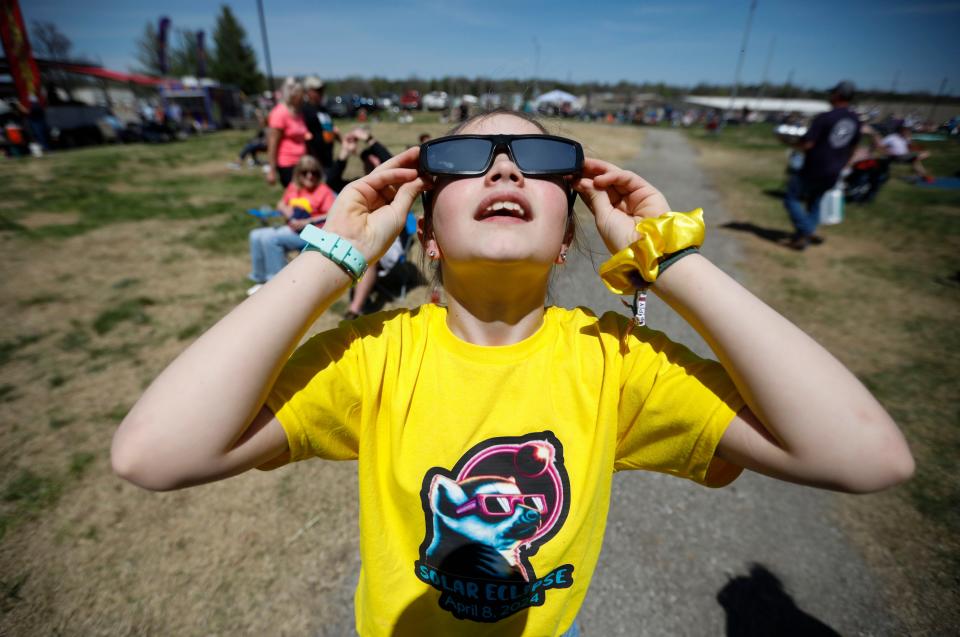The Great American Solar Eclipse is over. Here's what to know about the next one in 2044
Millions of people turned to the sky Monday afternoon to experience the Great American Solar Eclipse, which swept over much of the United States.
Parts of southeast Missouri, including Poplar Bluff, Cape Girardeau and West Plains were in the solar eclipse's path of totality, bringing thousands of tourists to the small cities. Reporting from West Plains, the News-Leader spoke with families all the way from Sacramento, California, and elsewhere, in addition to southern Missouri natives who made the hour or so drive.
As the moon's shadow made its way over the sun on Monday afternoon, hundreds of eclipse enthusiasts clapped and cheered with excitement outside of the West Plains Civic Center. Ashley Kreikemeier and her five children of Weston, Nebraska, were among the crowd, sporting bright yellow custom-made T-shirts with the eclipse's date on the front. The family made the 10-hour drive to West Plains to create a "core memory" together, 9-year-old Charlie Kreikemeier told the News-Leader ahead of totality.

Saralyn and Scott Crawford of Ozark, along with their two children Kaliana, 10, and Maxwell, 6, were also among the crowds at the West Plains Civic Center. The family drove to Jefferson City to experience the total solar eclipse in 2017 and were eager to experience totality again as a family this spring.
More: One family traveled 2,000+ miles, others watched from backyards as the Ozarks went dark
When is the next solar eclipse?
The next solar eclipse that can be seen from the continental United States will be on Aug. 23, 2044, according to NASA.
Unlike Monday's eclipse, only three states will be in the path of totality in 20 years: Montana, North Dakota and South Dakota, according to National Eclipse, an online resource for solar eclipses. However, a partial solar eclipse will be seen over parts of Alaska, Arizona, California, Colorado, Hawaii, Iowa, Idaho, Kansas, Michigan, Minnesota, Missouri, Nebraska, New Mexico, Nevada, Oklahoma, Oregon, Texas, Utah, Washington and Wyoming.
Can you reuse, recycle solar eclipse viewing glasses?

If you were in the path of totality during the 2017 solar eclipse, or even in an area that experienced a partial solar eclipse, you may have held onto your viewing glasses for Monday's festivities. But with the next eclipse not for another 20 years, millions are wondering what they should do with the movie theater-like glasses.
According to the American Astronomical Society, solar eclipse viewing glasses do not expire, as long as they met the ISO 12312-2 certification. Folks should store viewing glasses carefully, because if the filters become scratched, punctured, torn or come loose from their frames, they should be discarded.
"To maintain your solar viewers in excellent condition, store them at room temperature, either in the case or package they came in or in an envelope or other container that will keep them clean and dry and protect them against scratches and punctures," the American Astronomical Society advises on its website.
If you don't have an interest in holding onto your viewing glasses, you can also donate them.

Eclipse Glasses USA, an eclipse viewing glasses manufacturer, is hosting a recycling drive. Viewing glasses donated to Eclipse Glasses USA will be distributed to other countries for upcoming eclipse events.
Eclipse Glasses USA only accepts US-made paperboard viewing glasses that feature the manufacturer's address and contact information, along with the official ISO logo. Glasses can be mailed to Eclipse Glasses USA, LLC PO Box 50571, Provo, Utah 84605. For more information about the drive, contact Eclipse Glasses USA at info@eclipse23.com.
Additionally, you can also recycle eclipse viewing glasses by discarding and throwing away the filters and recycling the cardboard frames.
Do your eyes hurt after looking at the sun?
Though viewers were consistently encouraged to not look directly at the sun during Monday's solar eclipse, some people may have been tempted. If you decided to take a forbidden peek, be mindful of any unusual symptoms you may be experiencing.
If you're feeling pain after looking at the solar eclipse, it may not be a sign of solar retinopathy, which is damage to the eye's retina from looking directly at the sun or other bright objects. The eye's retina does not have pain receptors, so damage from the eclipse would not result in pain or discomfort.
However, if you are concerned about sustained damage, the American Academy of Ophthalmology recommends looking for the following symptoms:
Blurry vision
Headache
A blind spot in your central vision in one or both eyes
Increased sensitivty to light
Distorted vision, such as a straight line looking bent or a door jam looking curvy
Changes in the way you perceive color
If you are experiencing any of these symptoms following Monday's solar eclipse, contact a health care provider.
Unfortunately, solar retinopathy is not curable and there is no treatment.
Greta Cross is the trending topics reporter for the Springfield News-Leader. Follow her on X and Instagram @gretacrossphoto. Story idea? Email her at gcross@gannett.com.
This article originally appeared on Springfield News-Leader: Next total solar eclipse in U.S. is in 2044. Here's what to know

